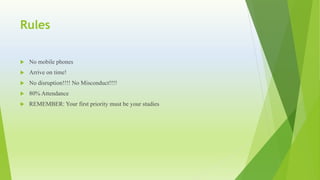
Rules for Success
- 1. Rules No mobile phones Arrive on time! No disruption!!!! No Misconduct!!!! 80% Attendance REMEMBER: Your first priority must be your studies
- 3. Generation of Computers • Computer generation are divided into 5 types : • First Generation (Vacuum Tubes) • Second Generation(Transistors) • Third Generation(Integrated Circuit) • Fourth Generation(Microprocessors) • Fifth Generation(Artificial Intelligence)
- 4. First Generation (Vacuum Tubes) (1940 - 1956) Computers of this generation used vacuum tubes to perform calculations vacuum tubes were expensive because of the amount of material and skill needed to manufacture them. Vacuum tubes get hot and burn out computers of this generation were very large machines. Special rooms with air conditioning were needed to house them because of the heat generated by the vacuum tubes. The most important computers of this generation were ENIAC-1 (Electronic Numerical Integrator and Computer), UNIVAC – 1 (Universal Automatic Computer).
- 5. Picture of ENIAC - 1 (Electronic Numerical Integrator and Computer)
- 6. UNIVAC Picture of (Universal Automatic Computer)
- 7. Second generation (1956 - 1963) The second generation of computers use of transistors instead of vacuum tubes. Transistors were widely used in computers from 1956 to 1963. Transistors were smaller than vacuum tubes and allowed computers to be smaller in size, faster in speed, and cheaper to build. Advantages : 1) 200 transistors are about same size as one vacuum tube in a computer. 2) Much less expensive than a vacuum tube. 3) A transistor can work 40 times faster than a vacuum tube. 4) Do not get hot & burn like a vacuum tube. Typical example of this generation are as follow :- IBM 7094 SERIES ,IBM 1400 SERIES , CDC 164 etc.
- 8. DIFFERENT PICTURES OF TRANSISTORS
- 9. Third generation (1964 - 1971) The third generation of computers introduced the use of IC (integrated circuits) in computers. Using IC's in computers helped reduce the size of computers even more compared to second-generation computers, as well as make them faster. These computer used magnetic core memory as internal storage all computers since the mid to late 1960s have utilized IC's. While the third generation is considered by many people to have spanned from 1964 to 1971, IC's are still used in computers today. Over 45 years later, today's computers have deep roots going back to the third generation.
- 10. IC’s PICTURES
- 11. Fourth generation (1972 - 2010) The fourth generation of computers took advantage of the invention of the microprocessor, more commonly known as a CPU. Microprocessors, along with integrated circuits, helped make it possible for computers to fit easily on a desk and for the introduction of the laptop. Some of the earliest computers to use a microprocessor include the Altair 8800, IBM 5100, and Micral. Today's computers still use a microprocessor, despite the fourth generation being considered to have ended in 2010.
- 12. Fifth generation (2010 to present) The fifth generation of computers is beginning to use AI (artificial intelligence), an exciting technology that has many potential applications around the world. Leaps have been made in AI technology and computers, but there is still much room for improvement. One of the more well-known examples of AI in computers is IBM's Watson, which has been featured on the TV show Jeopardy as a contestant. Other better-known examples include Apple's Siri on the iPhone and Microsoft's Cortana on Windows 8 and Windows 10 computers. The Google search engine also utilizes AI to process user searches.
- 13. ASSIGMENT NO 1
Editor's Notes
- Advantages 1. Only vacuum tubes are required. Disadvantages 1. Generates heat. 2. Airconditioning required. 3. Large in size. 4. Unreliable. 5. Constant maintenance required.
- Advantages 1. Less heat generation. 2. Smaller in size compared to the first generation. 3. More reliable. 4. Faster in action. Disadvantages 1. Airconditioning required. 2. Maintenance required.
- Advantages 1. Smaller in size. 2. Lower heat generation. 3. Less power requirement. 4. More reliable than the first and second generation. 5. Faster than the first and second generation. 6. Low maintenance cost. 7. Easily portable. 8. Cheaper commercial production. Disadvantages 1. Manufacturing difficulty. 2. Airconditioning required.
- Advantages 1. Smaller in size. 2. Portable. 3. No air conditioning required. 4. Practically maintenance free. 5. Cheaper and reliable. 6. Less power requirement. 7. General purpose and much cheaper. Disadvantages 1. Complex software. 2. The highly sophisticated technology required for manufacturing LSIC ( large scale integrated circuit)